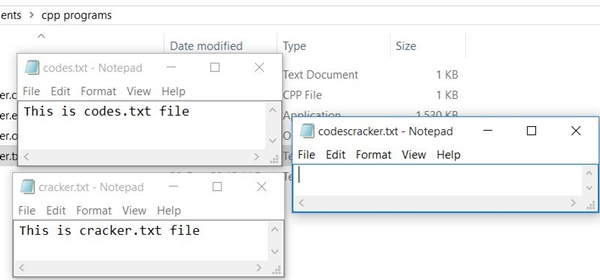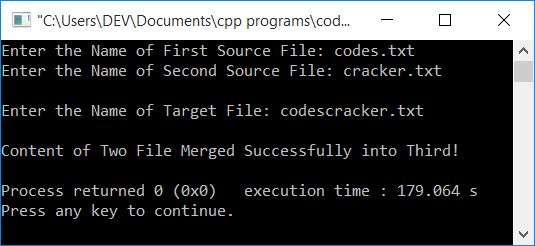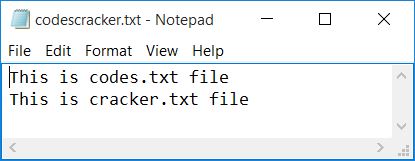- C++ Programming Examples
- C++ Programming Examples
- C++: Hello World
- C++: Get Input
- C++: Print Integer
- C++: Add two numbers
- C++: Add, Sub, Multiply, Div
- C++: Add Digits
- C++: Find Average and Percentage
- C++: Find Arithmetic Mean
- C++: Sum of n Natural Numbers
- C++: Sum of n Numbers
- C++: Square's Area and Perimeter
- C++: Rectangle's Area and Perimeter
- C++: Triangle's Area and Perimeter
- C++: Area and Circumference
- C++: Find Simple Interest
- C++: Fahrenheit to Celsius
- C++: Celsius to Fahrenheit
- C++: Print Prime Numbers
- C++: Reverse a Number
- C++: Swap Two Numbers
- C++: Print Multiplication Table
- C++: Find Factorial of a Number
- C++: Find Factors of a Number
- C++: Find HCF and LCM
- C++: Create a Calculator
- C++: Count Digits in a Number
- C++: First and Last Digit Sum
- C++: Product of Number Digits
- C++: Sum of Squares of Digits
- C++: Interchange Digits of Number
- C++ if-else Programs
- C++: Check Even or Odd
- C++: Check Prime or Not
- C++: Check Alphabet or Not
- C++: Check Vowel or Not
- C++: Check Leap Year or Not
- C++: Check Reverse equals Original
- C++: Check Perfect Number
- C++: Check Palindrome or Not
- C++: Check Armstrong or Not
- C++: Divisibility Test
- C++: Find Labor Wage
- C++: Find Discounted Price
- C++: Find Shipping Charge
- C++: Find Telephone Bills
- C++: Calculate Student Grade
- C++: Largest of Two Numbers
- C++: Largest of Three Numbers
- C++ Number Conversion
- C++: Decimal to Binary
- C++: Decimal to Octal
- C++: Decimal to Hexadecimal
- C++: Binary to Decimal
- C++: Binary to Octal
- C++: Binary to Hexadecimal
- C++: Octal to Decimal
- C++: Octal to Binary
- C++: Octal to Hexadecimal
- C++: Hexadecimal to Decimal
- C++: Hexadecimal to Binary
- C++: Hexadecimal to Octal
- C++ Pattern Programs
- C++: Pattern Programs
- C++: Print Diamond Pattern
- C++: Print Floyd's Triangle
- C++: Print Pascal's Triangle
- C++ Array Programs
- C++: 1D Array Program
- C++: Linear Search
- C++: Binary Search
- C++: Largest Element in an Array
- C++: Smallest Element in an Array
- C++: Find Second Largest Element
- C++: Find Second Smallest Element
- C++: Sum of All Elements
- C++: Multiply All Elements
- C++: Element in Even Position
- C++: Element in Odd Position
- C++: Print Even Numbers in Array
- C++: Print Odd Numbers in Array
- C++: Count Even or Odd Numbers
- C++: Sum of Even or Odd Numbers
- C++: Count Positive, Negative, Zero
- C++: Reverse an Array
- C++: Insert an Element
- C++: Delete an Element
- C++: Merge two Arrays
- C++: Bubble Sort
- C++: Selection Sort
- C++: Insertion Sort
- C++: Common Elements
- C++: 2D Array Programs
- C++: Add Two Matrices
- C++: Subtract Two Matrices
- C++: Transpose Matrix
- C++: Multiply Two Matrices
- C++: 3D Array Programs
- C++ String Programs
- C++: Print String
- C++: Find String Length
- C++: Compare Two Strings
- C++: Copy String
- C++: String Concatenation
- C++: Reverse a String
- C++: Delete Vowels from a String
- C++: Delete a Word from a String
- C++: Count Characters in a String
- C++: Count Words in a String
- C++: Frequency of Words
- C++: Remove Spaces from Strings
- C++: Sort a String
- C++: Uppercase to Lowercase
- C++: Lowercase to Uppercase
- C++: Swap Two Strings
- C++: Check the Anagram or Not
- C++: Capitalize All Words in a String
- C++: Get Numbers from a String
- C++ File Programs
- C++: Read a File
- C++: Write Content to a File
- C++: Append Data to a File
- C++: Read and Display File
- C++: Copy a File
- C++: Merge Two Files
- Count Characters in a File
- C++: Capitalize Every Word
- C++: List Files in Directory
- C++: Delete a File
- C++: Encrypt and Decrypt a File
- C++ Misc Programs
- C++: Print ASCII Value
- C++: Add Binary Numbers
- C++: Generate Random Numbers
- C++: Print a Smiling Face
- C++: Days into Years and Months
- C++: Add Two Numbers using Pointer
- C++: Print Fibonacci Series
- C++: Generate Armstrong Numbers
- C++: Find nCr and nPr
- C++: Get IP Address
- C++: Print Date and Time
- C++: Shutdown and Restart Computer
- C++ Programming Tutorial
- C++ Tutorial
C++ Program to Merge Two Files
In this article, you will learn and get code to merge the content of any two files into a third file using a C++ program. The names of all three files must be entered by the user at runtime.
Things to Do Before the Program
Because the purpose of this article is to provide you with the C++ source code for merging two files, you must have or create all three files within the current directory.The current directory is the directory where your C++ source code to merge two files is saved.
Therefore, create the first source file named codes.txt with the following content:
This is codes.txt file
And then create a second source file named cracker.txt with the following content:
This is cracker.txt file
Now create the third file (the target file) without any content (empty content). The name of the third file is codescracker.txt.
You can name the file whatever you want. But remember to provide the names of these files while executing the program given below to merge the content of two files into a third file.
Because I'm going to save my C++ source code given below (to merge two files) in the cpp programs folder present inside its parent directory named Documents in the C-Drive of my computer system, Here is a screenshot of the cpp programs folder:

As you can see, there are three newly created files inside the folder "cpp programs." And here is the snapshot of all three files with their contents:

As you can clearly see, the content inside codes.txt and cracker.txt is available; but the codescracker.txt file is completely empty. Now let's move on to the program to merge the content of two files into the third (target) file.
In C++, merge the contents of two files into a third file
To merge two files in C++ programming, you have to ask the user to enter the names of all three files with their extensions, as shown in the program given below:
To do the task of merging, first receive the names of two files and open them in reading mode. If both files are successfully opened, the input will be used as the name of the third or target file.
The content of the first and second files gets copied one by one into the third file, as shown in the following program.
The question is: write a program in C++ that merges the content of two files into a third file. Here is its answer:
#include<iostream> #include<fstream> #include<stdio.h> using namespace std; int main() { char fileOne[30], fileTwo[30], fileTarget[30], ch; fstream fpsOne, fpsTwo, fpTarget; cout<<"Enter the Name of First Source File: "; gets(fileOne); cout<<"Enter the Name of Second Source File: "; gets(fileTwo); fpsOne.open(fileOne, fstream::in); fpsTwo.open(fileTwo, fstream::in); if((!fpsOne) || (!fpsTwo)) { cout<<"\nError Occurred (First Source File)!"; return 0; } else { cout<<"\nEnter the Name of Target File: "; gets(fileTarget); fpTarget.open(fileTarget, fstream::out); if(!fpTarget) cout<<"\nError Occurred (Target File)!"; else { while(fpsOne>>noskipws>>ch) fpTarget<<ch; fpTarget<<"\n"; while(fpsTwo>>noskipws>>ch) fpTarget<<ch; cout<<"\nContent of Two File Merged Successfully into Third!"; } } fpsOne.close(); fpsTwo.close(); fpTarget.close(); cout<<endl; return 0; }
This program was built and runs under the Code::Blocks IDE. Here is its sample run:

Now supply the names of the first two source files, say, codes.txt and cracker.txt. hen enter the name of the target file, say, codescracker.txt, to merge the content of the first two files into this file. At the start of this article, all three files are created. Now here is the sample output after providing these inputs:

As you can see, after entering the names of all three files, the message printed is "Content of Two Files Merged Successfully into Third!." Therefore, the content of the first two source files gets merged into the third file. You can open and see the third (target) file. Here is a snapshot of the target file, codescracker.txt, after executing the above program:

As you can see, the content of two source files gets merged into the target file. There is a newline inserted between both source files' content through the program.
But if you don't need to insert a newline between the content of both source files, then just remove the following code from the above program:
fpTarget<<"\n";
to copy the content in as it is without adding extra things like a newline.
The fstream library allows working with files. It is defined in the fstream header file.
The function, open() opens the file. It takes two arguments. The first argument is the name of the file, which is a required argument, and the second argument is its opening mode, which is an optional argument. The following code
fpsOne.open(fileOne, fstream::in);
opens the file fileOne in reading mode. And the file opening mode, fstream::out, opens a file in writing mode.
The following statement:
fpsOne>>noskipws>>ch
reads data from file through its stream, fpsOne, in a character-by-character manner without skipping white spaces. And the following statement:
fpTarget<<ch;
writes data to a file through its stream, fpTarget.
The same program in different languages
« Previous Program Next Program »